Home / Sodium Borohydride (NaBH4) Reduction of Aldehydes and Ketones
Aldehydes and Ketones
Sodium Borohydride (NaBH4) Reduction of Aldehydes and Ketones
Last updated: February 5th, 2025 |
Sodium borohydride (NaBH4) For the Reduction of Aldehydes and Ketones
- Sodium borohydride (NaBH4) is a convenient source of hydride ion (H-) for the reduction of aldehydes and ketones.
- Aldehydes are reduced to primary alcohols and ketones are reduced to secondary alcohols.
- Esters (including lactones) and amides are not reduced.
- As a source of hydride ion, NaBH4 will also act as a strong base, deprotonating water, alcohols, and carboxylic acids.
- NaBH4 also sees use in the reduction of organomercury bonds after oxymercuration reactions.
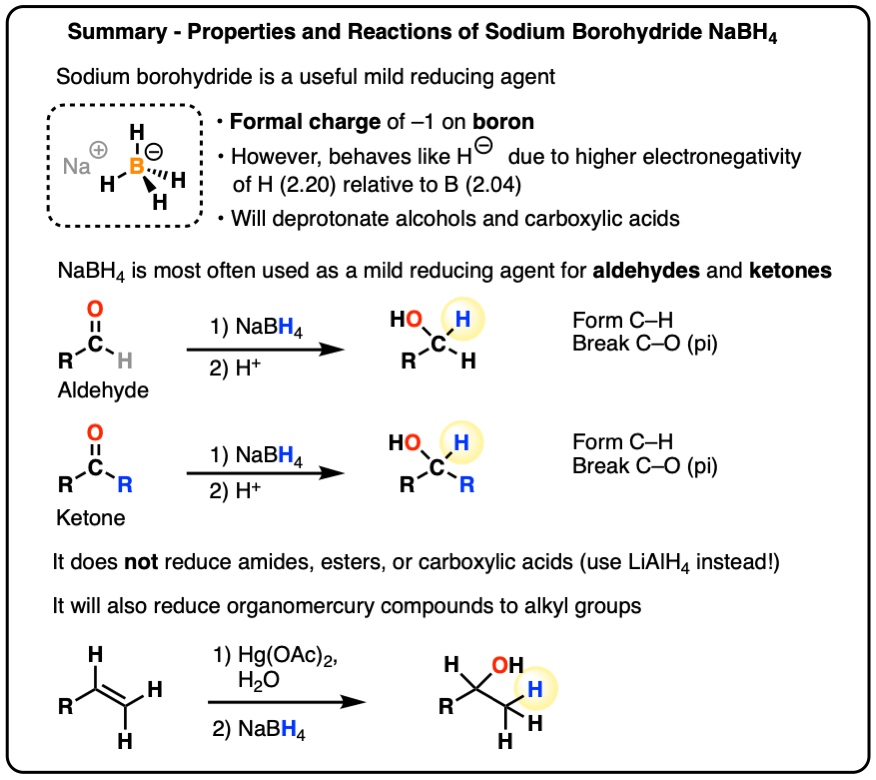
Table of Contents
-
- Sodium Borohydride, NaBH4
- NaBH4 For The Reduction of Aldehydes and Ketones
- Mechanism For the Reduction of Aldehydes and Ketones by Sodium Borohydride
- NaBH4 Will Not Reduce Esters or Amides
- Reduction of Hemiacetals
- Reduction of Organomercury Compounds with NaBH4
- Summary
- Notes
- Quiz Yourself!
- (Advanced) References and Further Reading
1. Sodium Borohydride (NaBH4 )
Sodium borohydride (NaBH4) can be made through the addition of sodium hydride (NaH) to our old friend borane (BH3 – See post: Hydroboration-Oxidation of Alkenes) in an appropriately chosen solvent [Note 1]. We generally don’t think of the hydride ion (NaH) as being a very good nucleophile, but the empty p-orbital of BH3 makes this addition much easier.
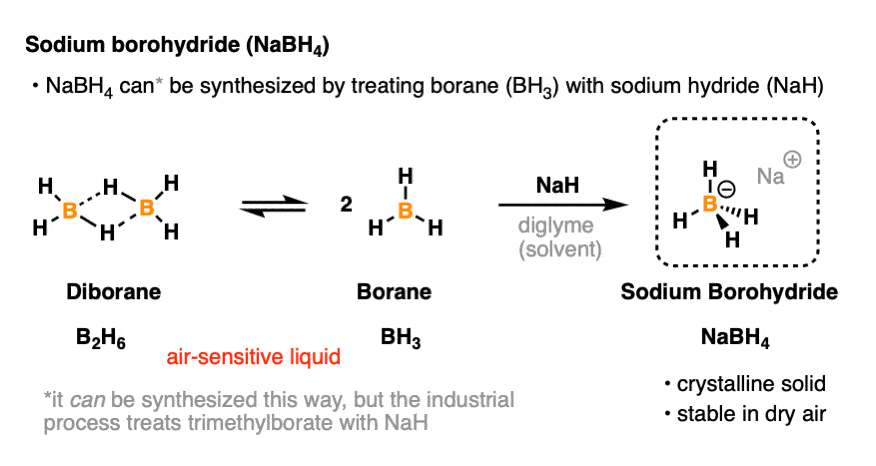
In contrast to BH3, which is a highly air-sensitive liquid requiring special inert-atmosphere (Schlenk line) techniques, sodium borohydride NaBH4 is a white crystalline solid generally dispensed in the form of pellets, very easily handled and weighed on the benchtop.
It’s worth a reminder about the properties of the B-H bond because this can be a common source of confusion.
NaBH4 has a tetrahedral arrangement of hydrogen atoms about the central boron atom, and a formal charge of -1 on the boron.
That negative charge on boron does not represent a lone pair on boron, however!
Because hydrogen is more electronegative (2.20) than boron (2.04) the electrons in the B–H bond are polarized towards the hydrogen.
So where are the electrons, if they’re not on the boron?
They’re on the hydrogens!
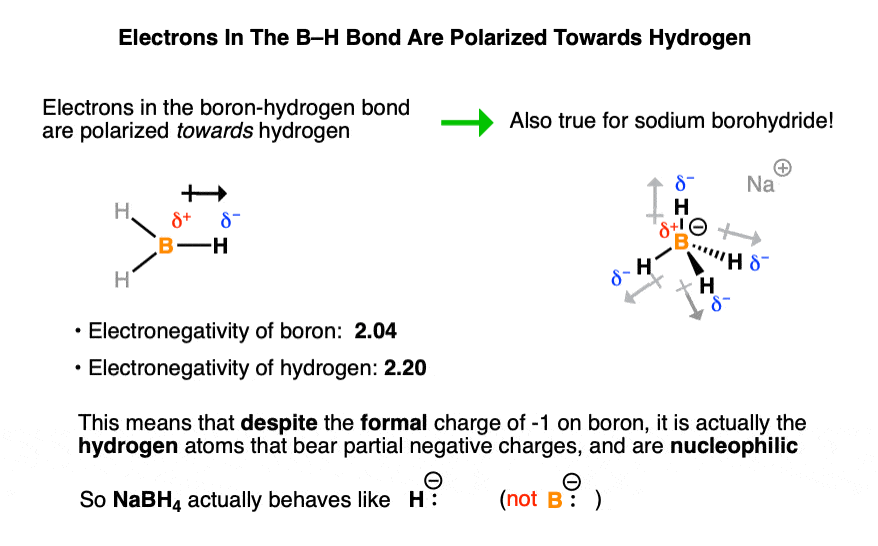
True to its name, sodium borohydride acts as a source of hydride ion, H(-).
You may recall that hydride is the conjugate base of hydrogen (H2) (pKa about 36), making it a very strong base. NaBH4 reacts with water and other weak acids (such as methanol) to generate hydrogen gas (H2).
See if you can draw an arrow-pushing mechanism for the formation of H2 :
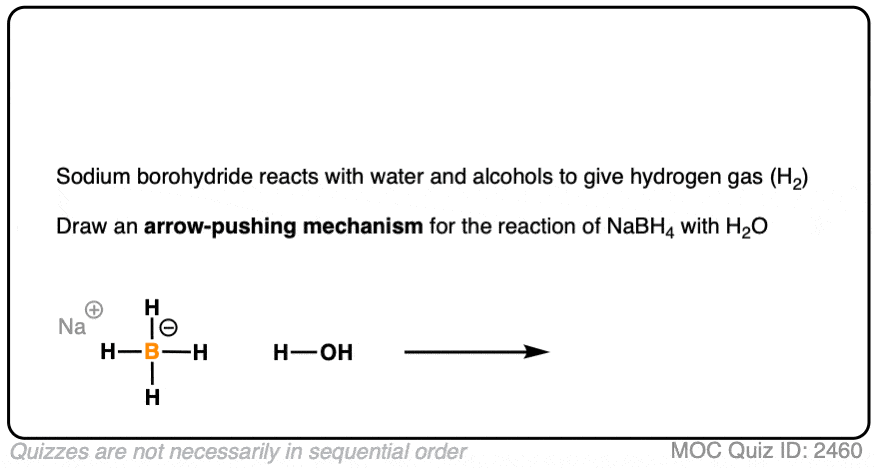 Click to Flip
Click to Flip
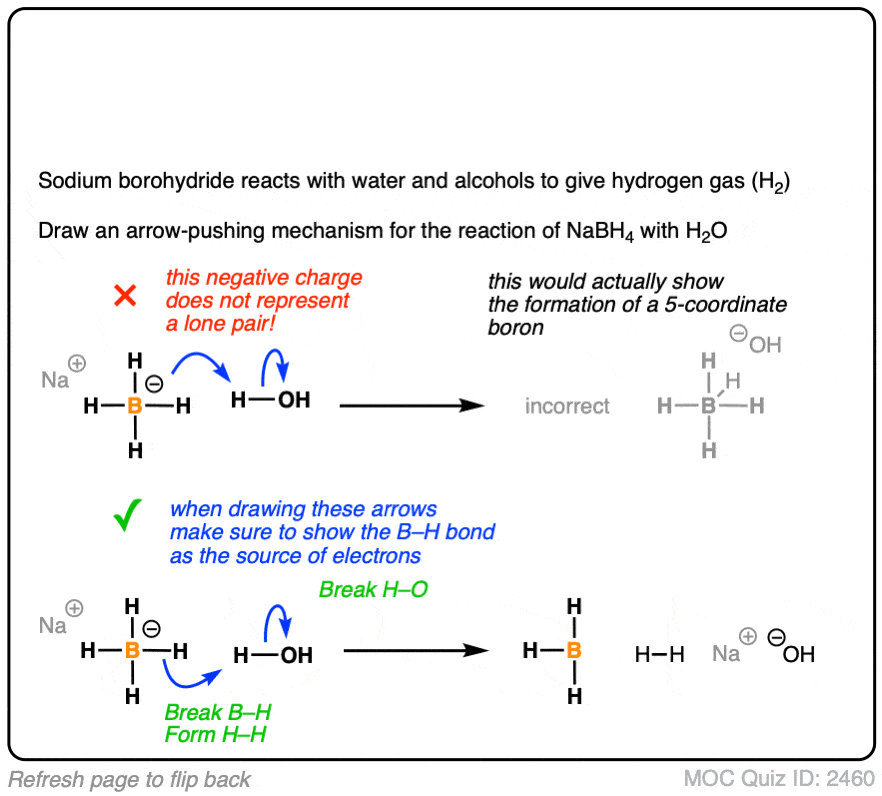
(It’s actually quite common to use methanol (CH3OH) as the solvent for sodium borohydride reductions. As long as the temperature is kept low (a dry ice / acetone cold bath at –78°C is common) the bubbling can be kept under control. It’s nowhere near as reactive towards water as lithium aluminum hydride (LiAlH4), which requires rigorously dry solvents to be used).
2. NaBH4 For The Reduction of Aldehydes and Ketones
The most important reaction of NaBH4 is its use in the reduction of aldehydes and ketones to give alcohols.
(You may recall that in organic chemistry, reduction generally refers to a process whereby a C-H bond is formed at the expense of a C-O bond. This results in a decrease in the oxidation state of the carbon – see article: Oxidation and Reduction in Organic Chemistry)
The reduction of aldehydes with sodium borohydride gives primary alcohols. Note the bonds that form and break here – a new C-H bond is formed, and a C-O (pi) is broken. An additional O-H bond forms during during a workup step with mild acid.
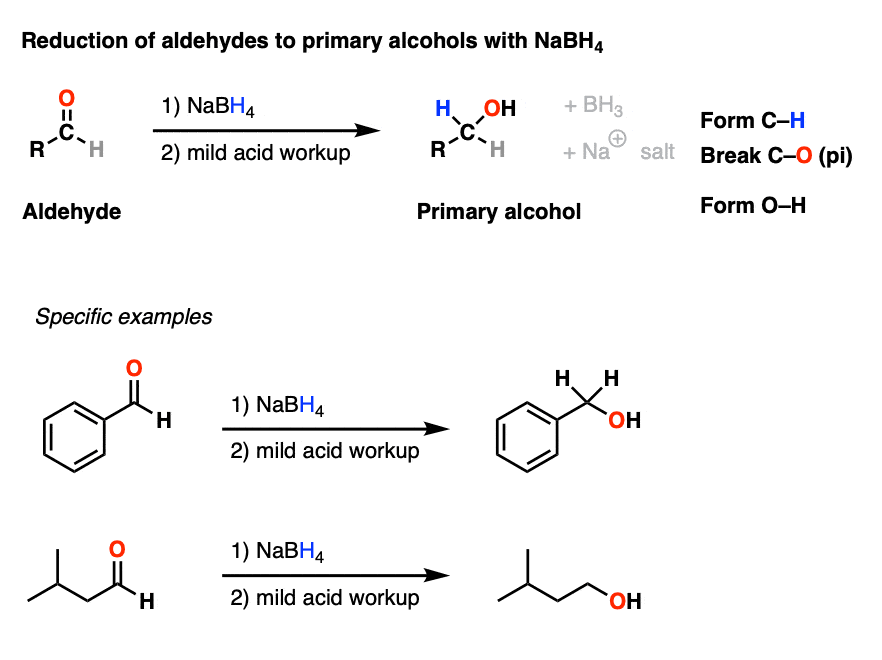
The reduction of ketones follows a similar pattern, and results in the formation of secondary alcohols. A C-H bond is formed and a C–O (pi) bond is broken.
Note that if the two R groups flanking the C=O bond are different, a new chiral center will be created. In the case of a simple ketone such as acetophenone (phenyl methyl ketone) this will result in a racemic mixture. (See article: What’s A Racemic Mixture?)
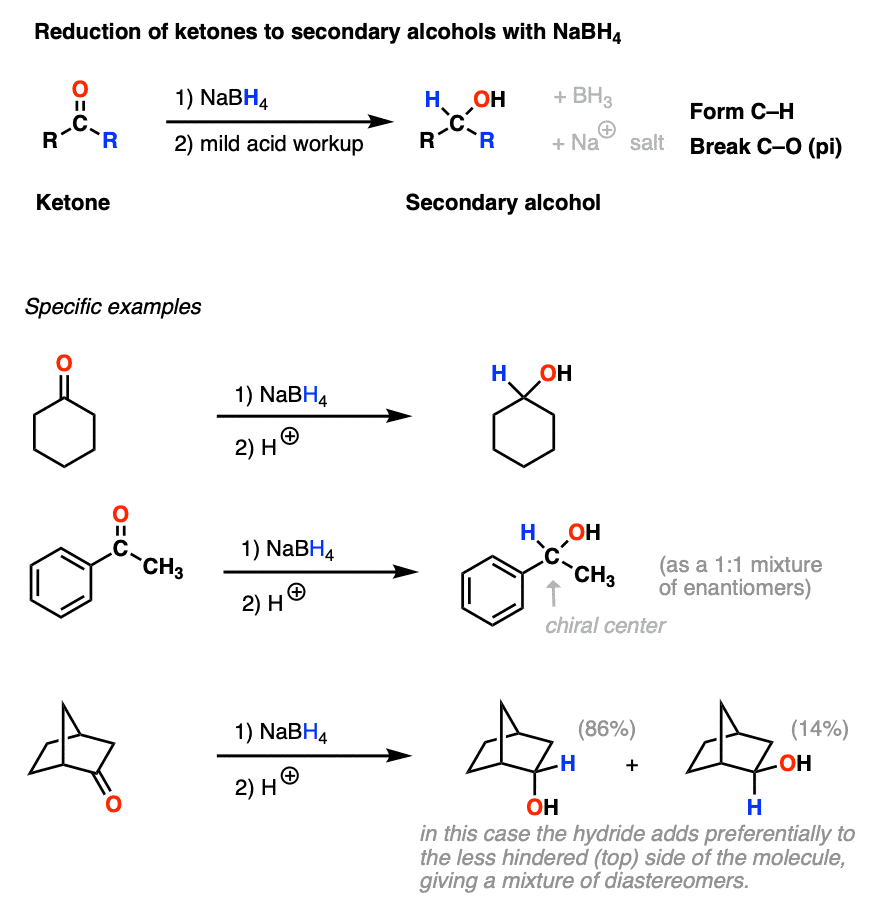
If the molecule already contains one or more stereogenic centers, a mixture of diastereomers will form. One notable example is the reduction of the bicyclic ketone [2.2.1]bicycloheptanone (above). Addition of the hydride ion occurs preferentially from the least hindered face (where there is only one bridging carbon) to give an 86:14 ratio of diastereomers.
Chiral reducing agents similar in reactivity to NaBH4 have been developed that are capable of performing enantioselective reductions of ketones. One prominent example is the CBS (Corey-Bakshi-Shibata) family of reagents.
3. Mechanism for the Reduction of Aldehydes and Ketones With NaBH4
The mechanism for these reductions follows the very common two-step addition-protonation pattern often found in reactions of aldehydes and ketones (See article: The Common Two-Step Pattern for Addition to Aldehydes and Ketones)
The first step in this reaction is nucleophilic addition to the carbonyl carbon. (See article: Nucleophilic Addition to Carbonyls), forming a C-H bond and breaking a C–O (pi) bond.
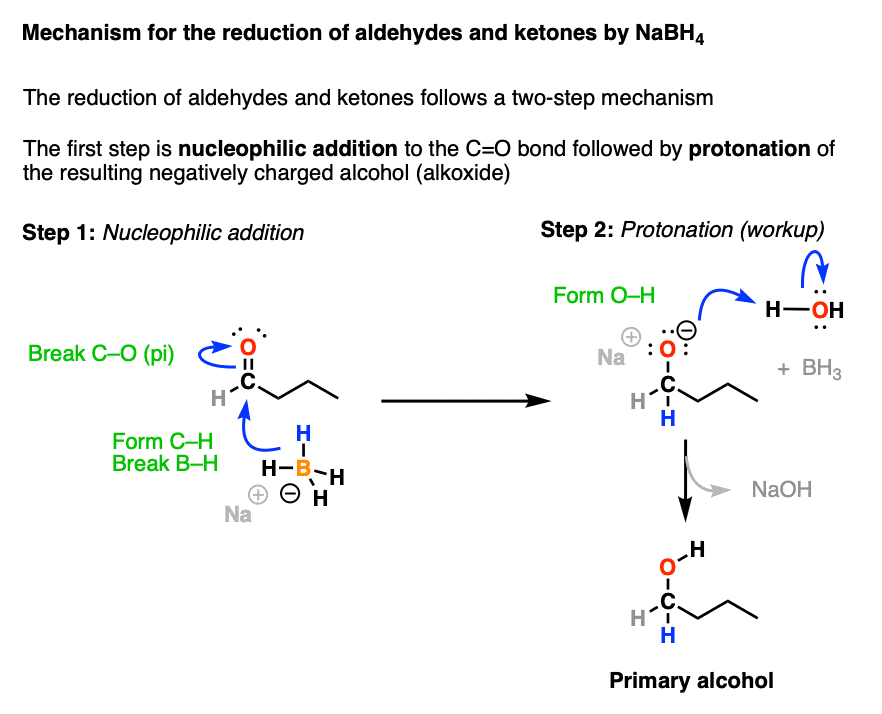
The addition is followed by protonation of the oxygen with a mild acid (leading to the formation of O–H).
In practice, this reaction is usually performed in an alcoholic solvent like CH3OH and the reaction is quenched with a mild acid such as a saturated solution of ammonium chloride (NH4Cl)
4. NaBH4 Will Not Reduce Esters or Amides
NaBH4 will not generally reduce esters or amides. (Note 2).
(This reaction can be done by LiAlH4 , however. See article – Lithium Aluminum Hydride LiAlH4)
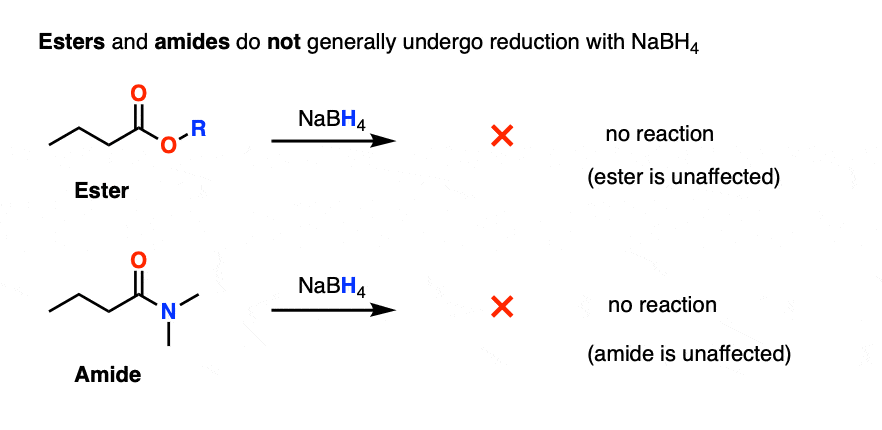
Why are esters and amides so unreactive? After all, shouldn’t these functional groups be more reactive than aldehydes and ketones since the carbonyl is attached to the electronegative oxygen and nitrogen atoms?
It’s actually the opposite! The lone pairs from oxygen and nitrogen are capable of donating electron density to the carbonyl carbon through forming a pi bond. This makes the carbonyl carbon less electrophilic and less reactive with nucleophiles.
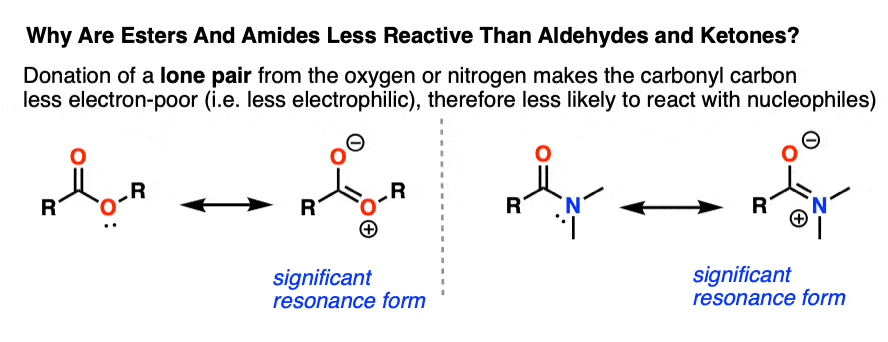
(You might recall that this is the exact same reason why OH and NH2 are activating groups in electrophilic aromatic substitution reactions – See Article: Understanding Ortho, Para and Meta Directors)
What about anhydrides and acid halides?
NaBH4 will reduce anhydrides and acid halides, but in practice, these functional groups will react with the solvent (CH3OH) before they have a chance to react with NaBH4.
5. Reduction of Hemiacetals
Aldehydes and ketones, check. Esters and amides, no go. So what else can be reduced by sodium borohydride.
The molecule below might look familiar. It’s glucose!
When treated with NaBH4, glucose is reduced to the alcohol sorbitol.
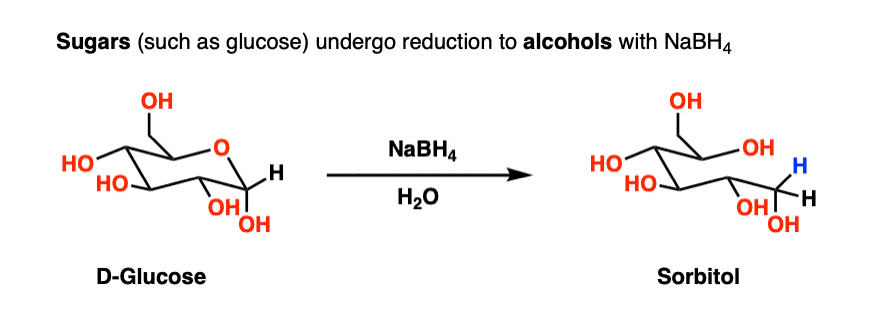
Hold on for a second. What happened here? There’s no aldehyde or ketone. Or is there?
There actually is an aldehyde present here, but it is in equilibrium with a cyclic hemiacetal. (In cyclic molecules such as sugars, this equilibrium process is known as ring-chain tautomerism – See Ring Chain Tautomerism in Sugars)
Although the open-chain aldehyde form only comprises 0.02% of an aqueous mixture of glucose at equilibrium, NaBH4 will quickly reduce any aldehyde that is present to give sorbitol. Via Le Chatelier’s principle, equilibrium between the cyclic hemiacetal and the aldehyde will eventually result in all of the cyclic hemiacetal being reduced to the alcohol.
See if you can draw the mechanism:
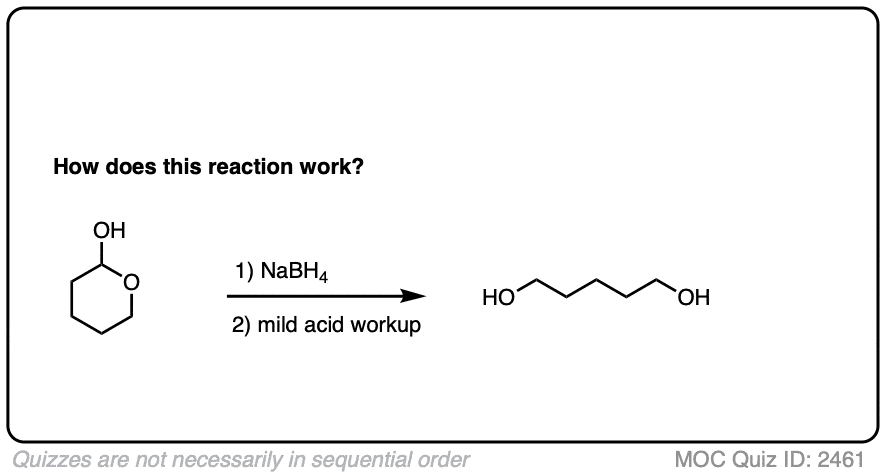 Click to Flip
Click to Flip
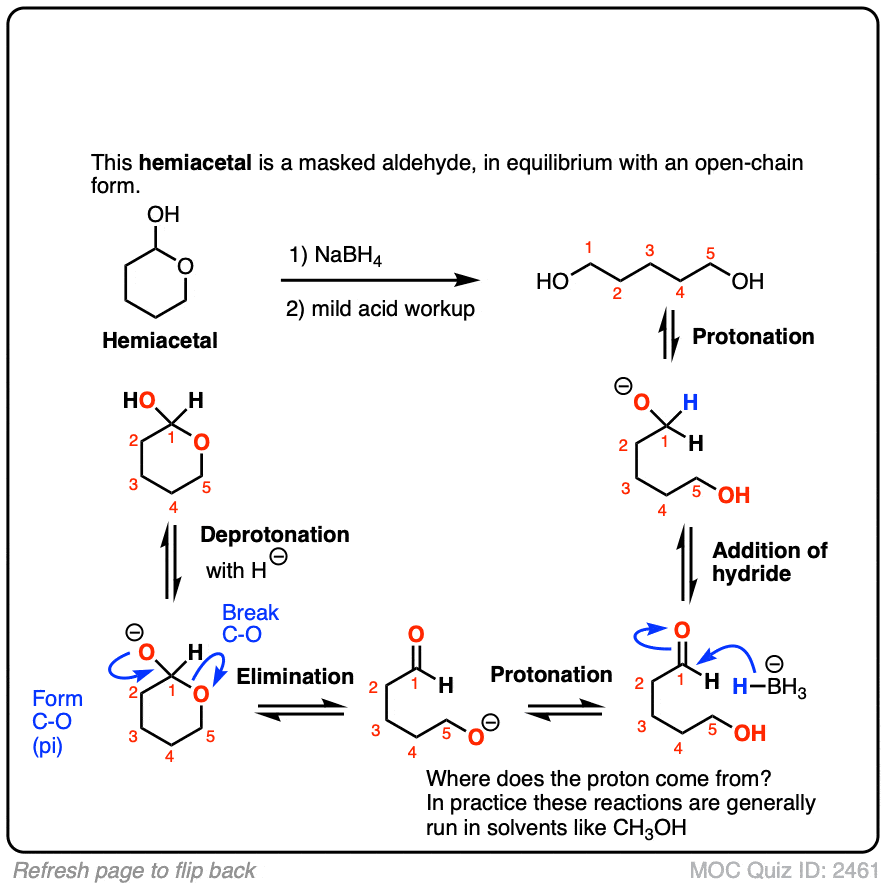
(Sodium borohydride can also be used in the reductive amination of iminium ions to give amines. For more on that, see this article on Reductive Amination. )
6. Reduction of Organomercury Compounds
There’s one more use of NaBH4 worth noting.
You may recall that alkenes can undergo oxymercuration when treated with water (or alcohols) in the presence of mercuric acetate Hg(OAc)2 or similar (See article – Oxymercuration of Alkenes) which results in net Markovnikov addition of water to an alkene.
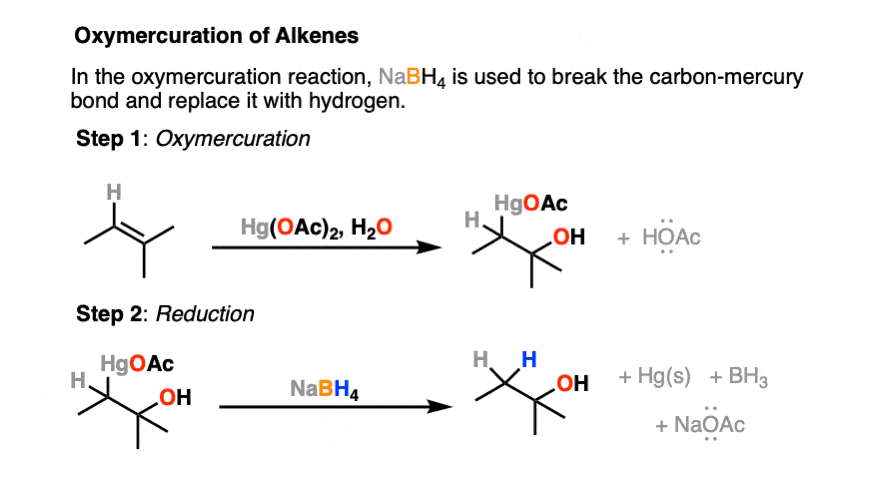
The resulting organomercury compound can then be treated with NaBH4 to give an alcohol.
The precise details of this “demercuration” step are often skipped over, but for completeness we’ll briefly go through it here.
The first step is addition of hydride to mercury, giving NaOAc and a new Hg-H bond. Carbon-mercury bonds are extremely weak (this is part of the reason why organomercury compounds are extremely toxic) and upon homolytic cleavage of Hg-C, the resulting carbon radical is then reduced with Hg-H to give C-H and metallic mercury (Hg0). On large enough scale, this results in a little puddle of mercury forming at the bottom of the reaction flask.
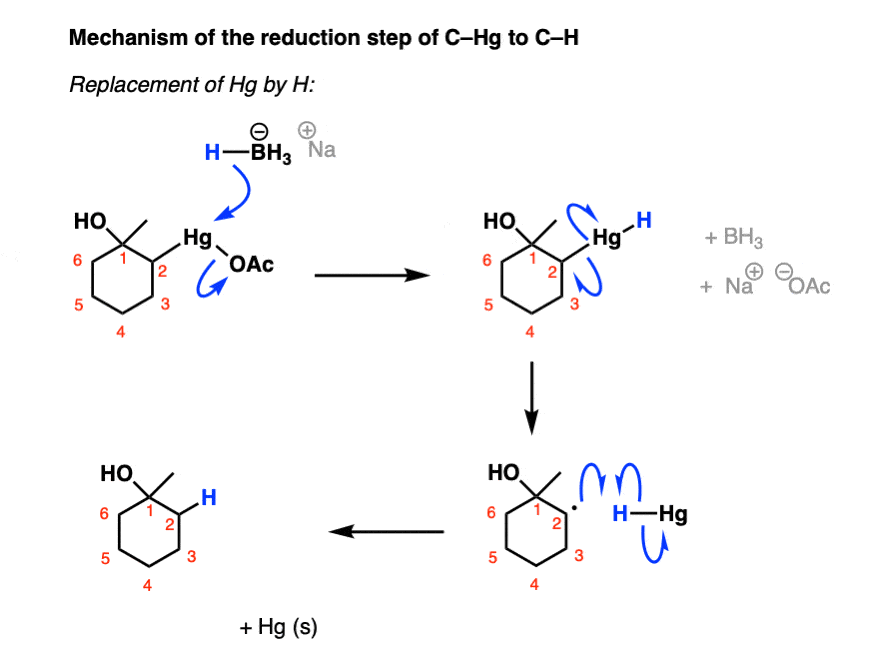
7. Summary
- Sodium borohydride will reduce aldehydes to primary alcohols and ketones to secondary alcohols.
- This proceeds via a two-step mechanism consisting of 1) nucleophilic addition, followed by 2) protonation.
- Esters and amides are not reduced by NaBH4 under normal conditions. (They can be reduced by lithium aluminum hydride (LiAlH4) however).
- NaBH4 is also used in the demercuration step of oxymercuration-demercuration.
Notes
Related Articles
- Lithium Aluminum Hydride (LiAlH4) For Reduction of Carboxylic Acid Derivatives
- Di-isobutyl Aluminum Hydride (DIBAL) For The Partial Reduction of Esters and Nitriles
- LiAlH[Ot-Bu]3 For The Reduction of Acid Halides To Aldehydes
- Oxidation and Reduction in Organic Chemistry
- Nucleophilic Addition To Carbonyls
- Addition-Elimination Mechanisms With Neutral Nucleophiles (Including Acid Catalysis)
- Aldehydes Ketones Reaction Practice (MOC Membership)
- Pyranoses and Furanoses: Ring-Chain Tautomerism In Sugars
Note 1. In practice NaBH4 is made on industrial scale by the treatment of trimethyl borate [B(OCH3)3] with sodium hydride at high temperatures (250°C).
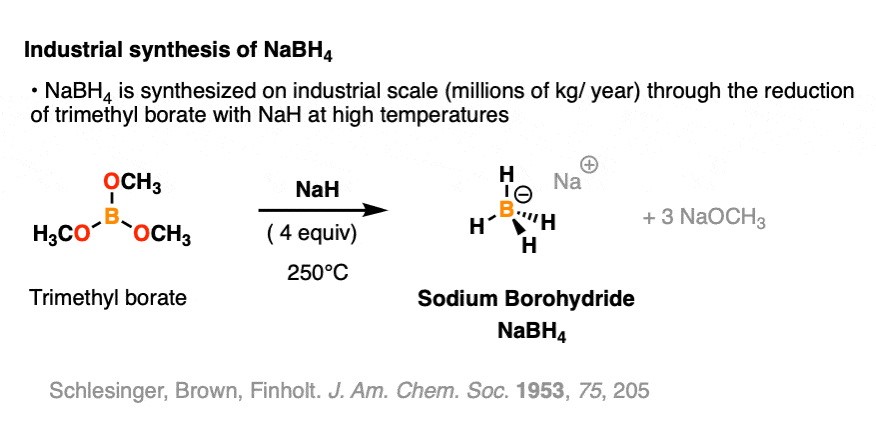
The reaction with LiH and BH3 in ether works well to make lithium borohydride, LiBH4. However the same reaction between NaH and BH3 requires using either THF or diglyme (ethylene glycol dimethyl ether) as the solvent, not diethyl ether.
Prior to the development of NaBH4, aldehydes and ketones were reduced either with sodium amalgam , sodium in alcohol solvent [Ref] , or through reductions such as the Meerwein-Pondorff-Verley reduction, all of which have various drawbacks. [Ref] Having a convenient crystalline solid as a bench-stable reducing agent has made reductions of aldehydes and ketones much more efficient.
Note 2. The reaction of esters with NaBH4 is extremely slow. However, lithium borohydride (LiBH4) will successfully reduce esters, owing to the greater Lewis acidity of the lithium ion that helps to activate the carbonyl oxygen towards attack. (See article – Acid Catalysis In Addition-Elimination Reactions)
Note 3. If protic solvents are rigorously excluded and the reaction is run in a polar aprotic solvent like DMF, the resulting product of sodium borohydride reduction will be a boronic ester.
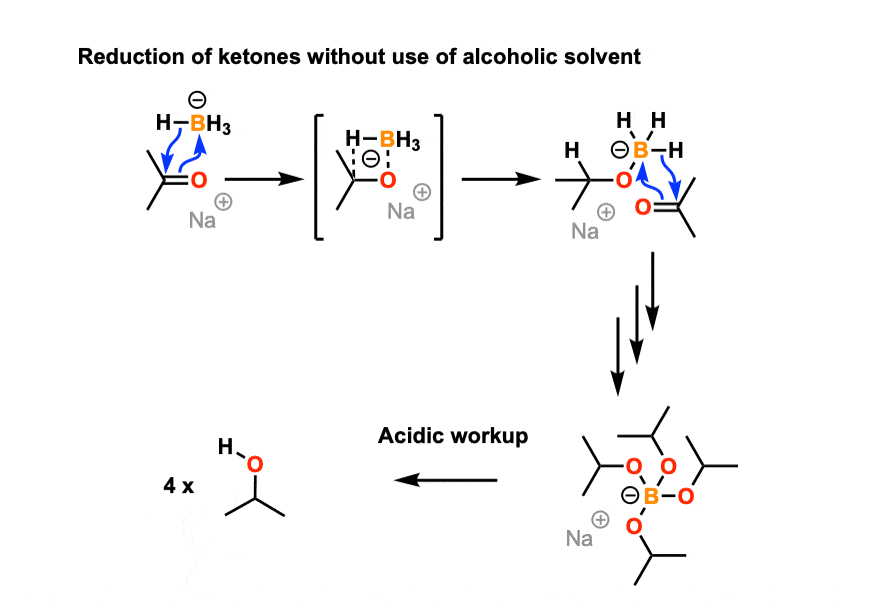
This article has more detail.
Note 4. The rate of reduction of cyclobutanone is about 3300 times faster than the reduction of cyclooctanone. This is due to the relief of ring strain upon going from sp2-hybridization (bond angle 120 °) to sp3 hybridization (109 .5 °) . Reduction of cyclo-octanone is considerably slower due to the presence of transannular strain in eight-membered rings.
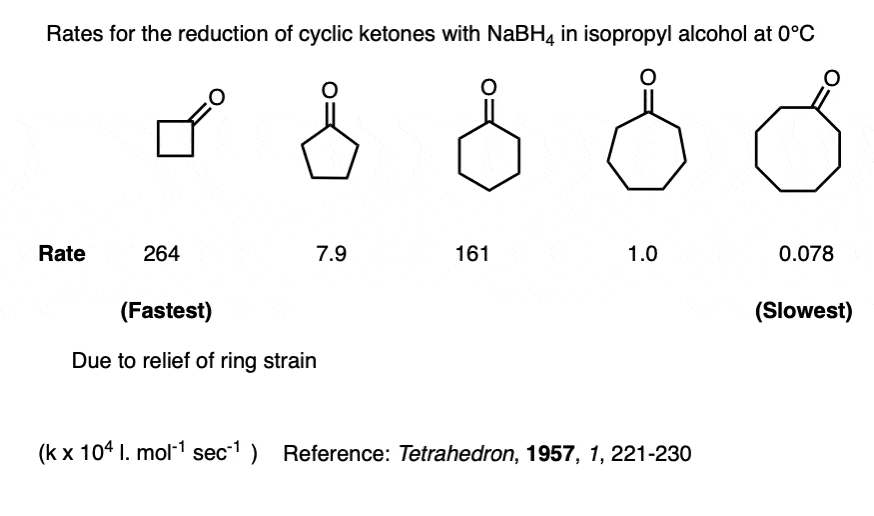
Quiz Yourself!
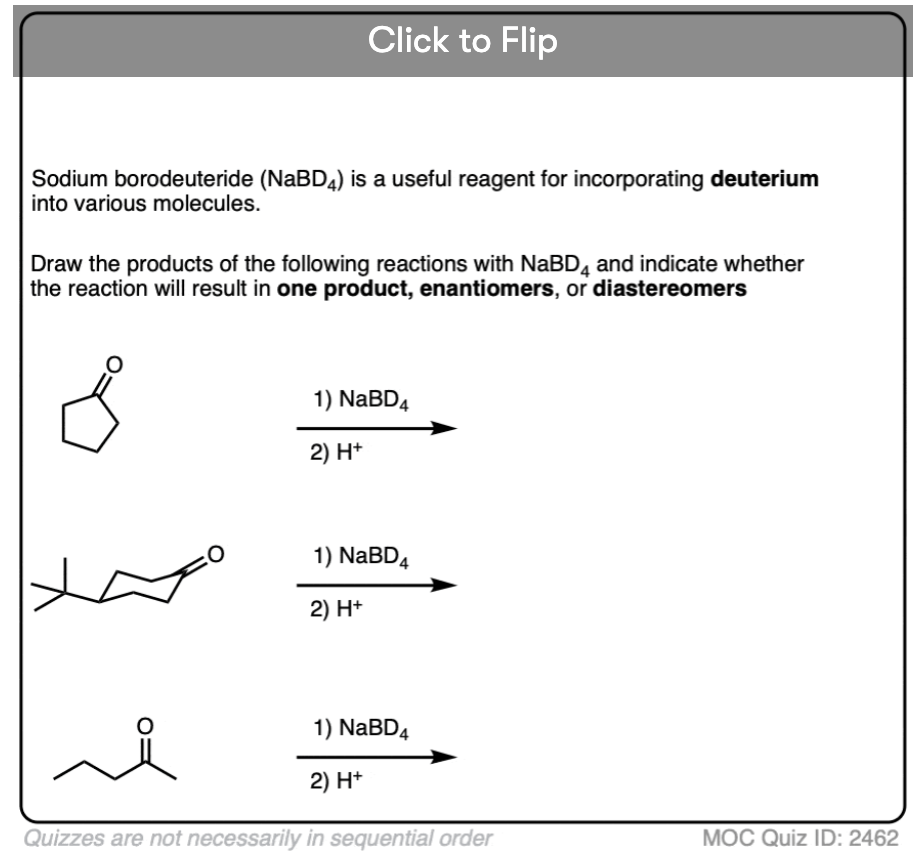
Become a MOC member to see the clickable quiz with answers on the back.
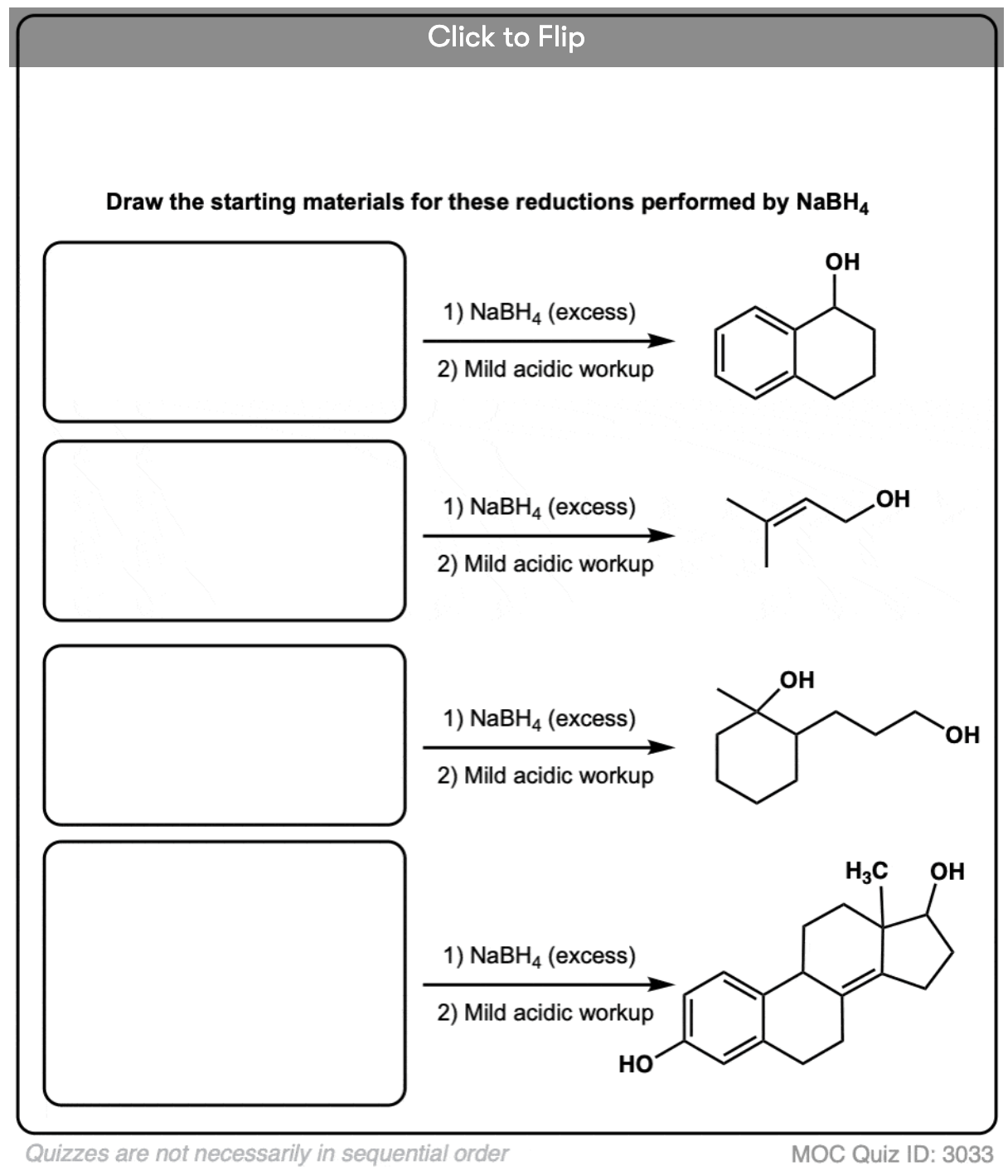
Become a MOC member to see the clickable quiz with answers on the back.
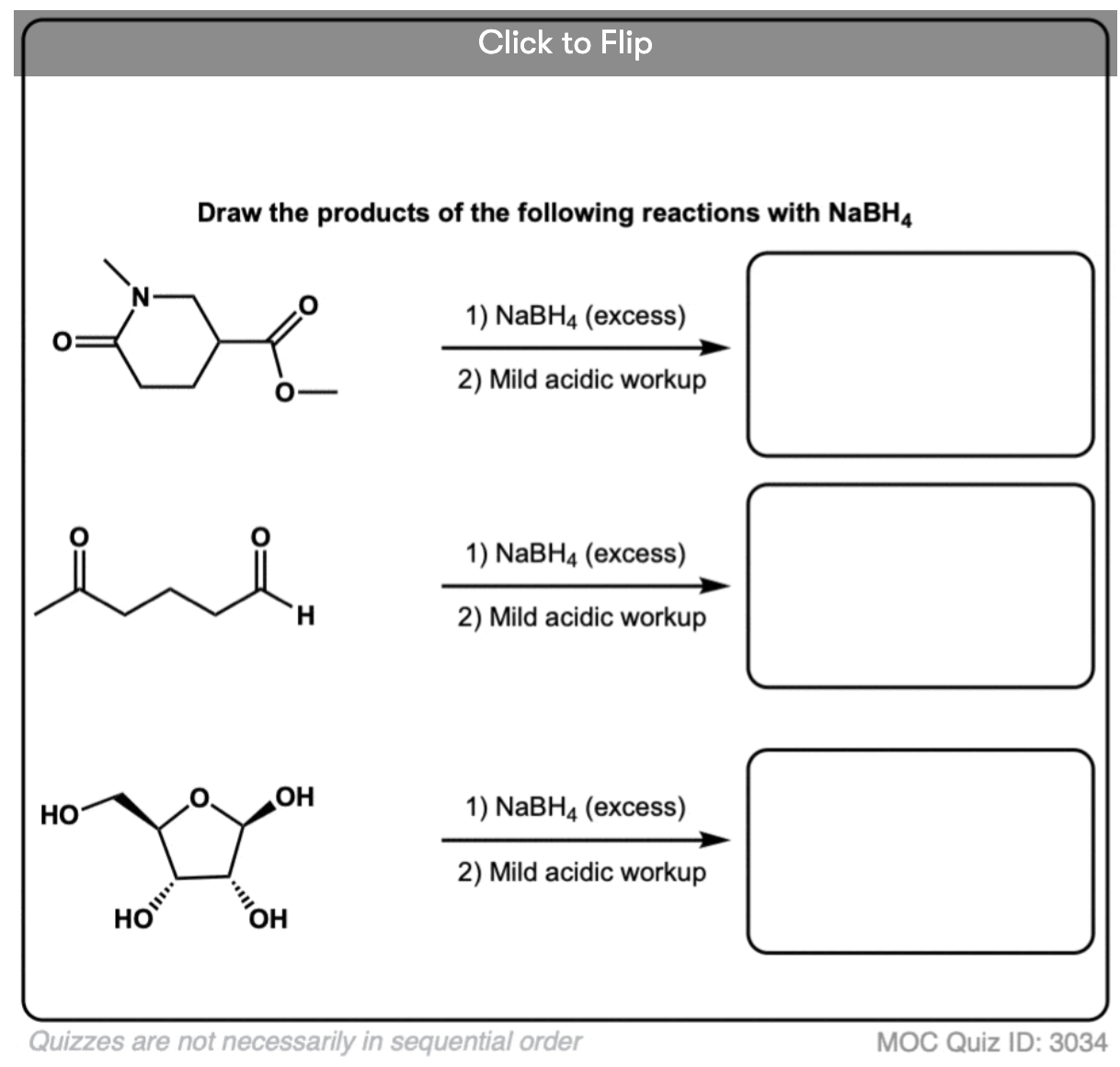
Become a MOC member to see the clickable quiz with answers on the back.
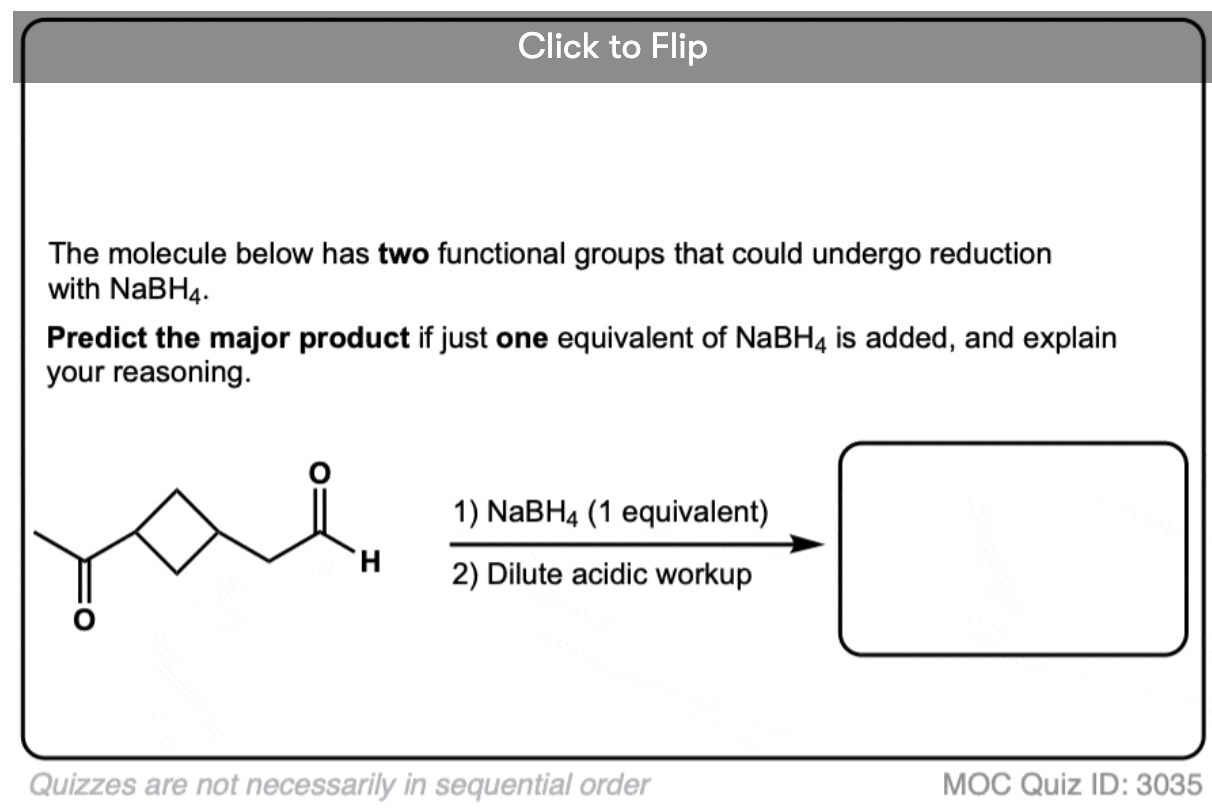
Become a MOC member to see the clickable quiz with answers on the back.
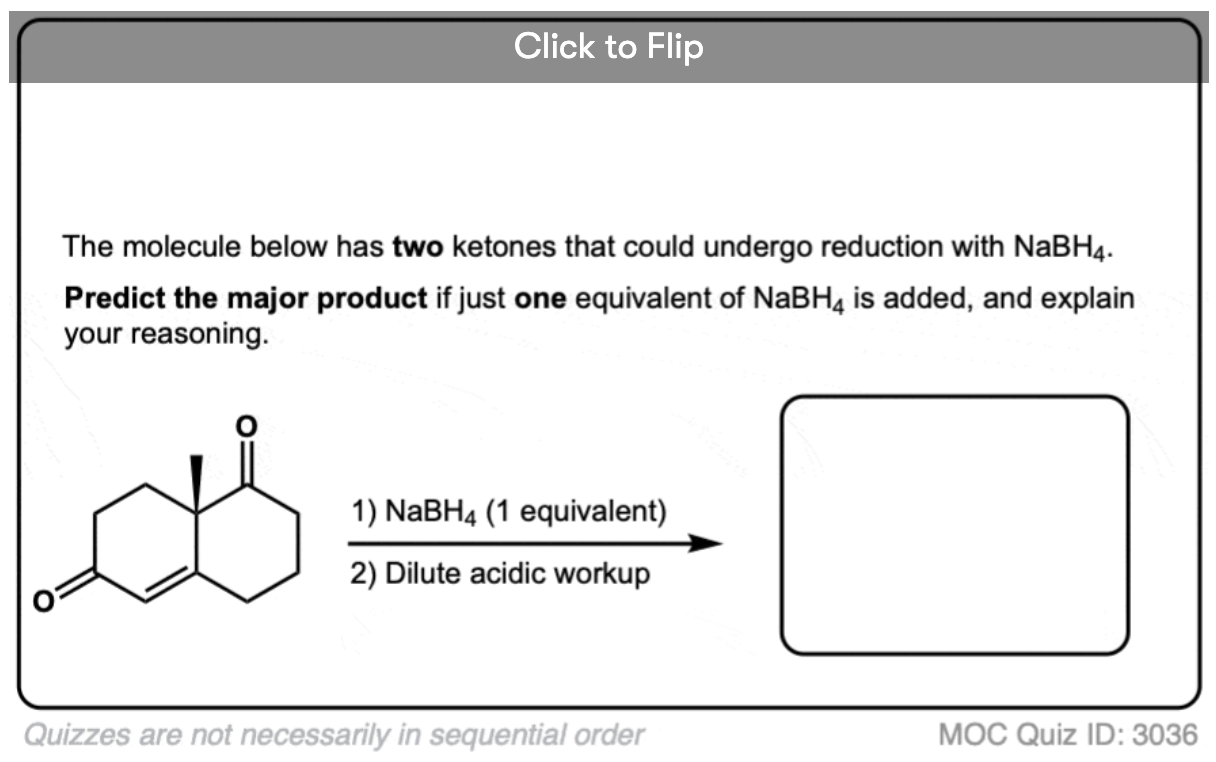
Become a MOC member to see the clickable quiz with answers on the back.
(Advanced) References and Further Reading
A useful (graduate-level) PDF handout on reducing agents can be found in these course notes from Prof Andrew G. Myers’ Chemistry 115 class at Harvard
Sodium borohydride was discovered in 1942 as part of a wartime research program toward finding volatile compounds of uranium that would enable isotopic enrichment through centrifugation. [Uranium (IV) borohydride, a volatile green solid, was synthesized in pound-scale quantities for this purpose].
- Forty Years of Hydride Reductions
Herbert C. Brown and S. Krishnamurthy
Tetrahedron, 1979, 35, 567-607
DOI: 10.1016/0040-4020(79)87003-9
A very accessible review on the history and development of hydride reducing agents, including NaBH4 and its many relatives. - The Preparation of Sodium Borohydride by the High Temperature Reaction of Sodium Hydride with Borate Esters
H. I. Schlesinger, Herbert C. brown, and A. E. FinholtJournal of the American Chemical Society 1953 75 (1), 205-209
DOI: 10.1021/ja01097a054
NaBH4 was discovered in 1942 but this work was not declassified until 1953. The prepration of NaBH4 through the method described in this paper is still in use today. - Reaction of Sodium Borohydride With Carbonyl Groups
Brown, H.C.; Wheeler, O.H.; Ichikawa, K.
Tetrahedron 1:214 (1957)
DOI: 10.1016/0040-4020(57)88041-7
Early paper by Nobel Laureate H. C. Brown describing the reactivities of simple aldehydes and ketones to reduction by NaBH4, in which it is shown that aldehydes are more reactive than ketones to nucleophilic reactions. - Mechanistic studies
Brown, H. C.; Ichikawa, K.
Tetrahedron 1:221 (1957)
DOI: 10.1016/0040-4020(57)88042-9
This paper and the above are both mechanistic studies on the reduction of carbonyls – this paper investigates the effect of ring size on the reduction of cyclic ketones (e.g. reduction of cyclobutanone vs. cyclopentanone, cyclohexanone, etc.). - Reference To An Experimental Procedure
Antonio Bermejo Gómez, Nanna Ahlsten, Ana E. Platero-Prats and Belén Martín-Matute
Org. Synth. 2014, 91, 185
DOI: 10.15227/orgsyn.091.0185
The first step in this procedure uses NaBH4 to reduce a cinnamyl ketone to the alcohol. - Reduction of ketones by sodium borohydride in the absence of protic solvents. Inter versus intramolecular mechanism.
Kayser, M., Eliev, S., & Eisenstein, O.
Tetrahedron Letters, 1983 24(10), 1015–1018.
DOI: 10.1016/S0040-4039(00)81590-7 - Lanthanides in organic chemistry. 1. Selective 1,2 reductions of conjugated ketones
Jean Louis Luche
Journal of the American Chemical Society 1978 100 (7), 2226-2227
DOI: 10.1021/ja00475a040
Using sodium borohydride for the reduction of unsaturated ketones sometimes results in the side reaction of conjugate reduction, i.e. the reduction of the double bond instead of the carbonyl. This paper shows that selectivity for 1,2-addition (to the carbonyl) can be greatly increased by treating the alpha,beta unsaturated ketone with 1.1 equivalent of the Lewis acid cerium chloride. This makes the carbonyl carbon more electrophilic and allows for a “chemoselective” reduction of the carbonyl. This procedure has become known as the Luche reduction.
00 General Chemistry Review
01 Bonding, Structure, and Resonance
- How Do We Know Methane (CH4) Is Tetrahedral?
- Hybrid Orbitals and Hybridization
- How To Determine Hybridization: A Shortcut
- Orbital Hybridization And Bond Strengths
- Sigma bonds come in six varieties: Pi bonds come in one
- Dipole Moments and Dipoles
- A Key Skill: How to Calculate Formal Charge
- The Four Intermolecular Forces and How They Affect Boiling Points
- 3 Trends That Affect Boiling Points
- How To Use Electronegativity To Determine Electron Density (and why NOT to trust formal charge)
- Introduction to Resonance
- How To Use Curved Arrows To Interchange Resonance Forms
- Evaluating Resonance Forms (1) - The Rule of Least Charges
- How To Find The Best Resonance Structure By Applying Electronegativity
- Evaluating Resonance Structures With Negative Charges
- Evaluating Resonance Structures With Positive Charge
- Exploring Resonance: Pi-Donation
- Exploring Resonance: Pi-acceptors
- In Summary: Evaluating Resonance Structures
- Drawing Resonance Structures: 3 Common Mistakes To Avoid
- How to apply electronegativity and resonance to understand reactivity
- Bond Hybridization Practice
- Structure and Bonding Practice Quizzes
- Resonance Structures Practice
02 Acid Base Reactions
- Introduction to Acid-Base Reactions
- Acid Base Reactions In Organic Chemistry
- The Stronger The Acid, The Weaker The Conjugate Base
- Walkthrough of Acid-Base Reactions (3) - Acidity Trends
- Five Key Factors That Influence Acidity
- Acid-Base Reactions: Introducing Ka and pKa
- How to Use a pKa Table
- The pKa Table Is Your Friend
- A Handy Rule of Thumb for Acid-Base Reactions
- Acid Base Reactions Are Fast
- pKa Values Span 60 Orders Of Magnitude
- How Protonation and Deprotonation Affect Reactivity
- Acid Base Practice Problems
03 Alkanes and Nomenclature
- Meet the (Most Important) Functional Groups
- Condensed Formulas: Deciphering What the Brackets Mean
- Hidden Hydrogens, Hidden Lone Pairs, Hidden Counterions
- Don't Be Futyl, Learn The Butyls
- Primary, Secondary, Tertiary, Quaternary In Organic Chemistry
- Branching, and Its Affect On Melting and Boiling Points
- The Many, Many Ways of Drawing Butane
- Wedge And Dash Convention For Tetrahedral Carbon
- Common Mistakes in Organic Chemistry: Pentavalent Carbon
- Table of Functional Group Priorities for Nomenclature
- Summary Sheet - Alkane Nomenclature
- Organic Chemistry IUPAC Nomenclature Demystified With A Simple Puzzle Piece Approach
- Boiling Point Quizzes
- Organic Chemistry Nomenclature Quizzes
04 Conformations and Cycloalkanes
- Staggered vs Eclipsed Conformations of Ethane
- Conformational Isomers of Propane
- Newman Projection of Butane (and Gauche Conformation)
- Introduction to Cycloalkanes
- Geometric Isomers In Small Rings: Cis And Trans Cycloalkanes
- Calculation of Ring Strain In Cycloalkanes
- Cycloalkanes - Ring Strain In Cyclopropane And Cyclobutane
- Cyclohexane Conformations
- Cyclohexane Chair Conformation: An Aerial Tour
- How To Draw The Cyclohexane Chair Conformation
- The Cyclohexane Chair Flip
- The Cyclohexane Chair Flip - Energy Diagram
- Substituted Cyclohexanes - Axial vs Equatorial
- Ranking The Bulkiness Of Substituents On Cyclohexanes: "A-Values"
- Cyclohexane Chair Conformation Stability: Which One Is Lower Energy?
- Fused Rings - Cis-Decalin and Trans-Decalin
- Naming Bicyclic Compounds - Fused, Bridged, and Spiro
- Bredt's Rule (And Summary of Cycloalkanes)
- Newman Projection Practice
- Cycloalkanes Practice Problems
05 A Primer On Organic Reactions
- The Most Important Question To Ask When Learning a New Reaction
- Curved Arrows (for reactions)
- Nucleophiles and Electrophiles
- The Three Classes of Nucleophiles
- Nucleophilicity vs. Basicity
- What Makes A Good Nucleophile?
- What Makes A Good Leaving Group?
- 3 Factors That Stabilize Carbocations
- Equilibrium and Energy Relationships
- 7 Factors that stabilize negative charge in organic chemistry
- 7 Factors That Stabilize Positive Charge in Organic Chemistry
- What's a Transition State?
- Hammond's Postulate
- Learning Organic Chemistry Reactions: A Checklist (PDF)
06 Free Radical Reactions
- Free Radical Reactions
- 3 Factors That Stabilize Free Radicals
- Bond Strengths And Radical Stability
- Free Radical Initiation: Why Is "Light" Or "Heat" Required?
- Initiation, Propagation, Termination
- Monochlorination Products Of Propane, Pentane, And Other Alkanes
- Selectivity In Free Radical Reactions
- Selectivity in Free Radical Reactions: Bromination vs. Chlorination
- Halogenation At Tiffany's
- Allylic Bromination
- Bonus Topic: Allylic Rearrangements
- In Summary: Free Radicals
- Synthesis (2) - Reactions of Alkanes
- Free Radicals Practice Quizzes
07 Stereochemistry and Chirality
- Types of Isomers: Constitutional Isomers, Stereoisomers, Enantiomers, and Diastereomers
- How To Draw The Enantiomer Of A Chiral Molecule
- How To Draw A Bond Rotation
- Introduction to Assigning (R) and (S): The Cahn-Ingold-Prelog Rules
- Assigning Cahn-Ingold-Prelog (CIP) Priorities (2) - The Method of Dots
- Enantiomers vs Diastereomers vs The Same? Two Methods For Solving Problems
- Assigning R/S To Newman Projections (And Converting Newman To Line Diagrams)
- How To Determine R and S Configurations On A Fischer Projection
- The Meso Trap
- Optical Rotation, Optical Activity, and Specific Rotation
- Optical Purity and Enantiomeric Excess
- What's a Racemic Mixture?
- Chiral Allenes And Chiral Axes
- Stereochemistry Practice Problems and Quizzes
08 Substitution Reactions
- Nucleophilic Substitution Reactions - Introduction
- Two Types of Nucleophilic Substitution Reactions
- The SN2 Mechanism
- Why the SN2 Reaction Is Powerful
- The SN1 Mechanism
- The Conjugate Acid Is A Better Leaving Group
- Comparing the SN1 and SN2 Reactions
- Polar Protic? Polar Aprotic? Nonpolar? All About Solvents
- Steric Hindrance is Like a Fat Goalie
- Common Blind Spot: Intramolecular Reactions
- Substitution Practice - SN1
- Substitution Practice - SN2
09 Elimination Reactions
- Elimination Reactions (1): Introduction And The Key Pattern
- Elimination Reactions (2): The Zaitsev Rule
- Elimination Reactions Are Favored By Heat
- Two Elimination Reaction Patterns
- The E1 Reaction
- The E2 Mechanism
- E1 vs E2: Comparing the E1 and E2 Reactions
- Antiperiplanar Relationships: The E2 Reaction and Cyclohexane Rings
- Bulky Bases in Elimination Reactions
- Comparing the E1 vs SN1 Reactions
- Elimination (E1) Reactions With Rearrangements
- E1cB - Elimination (Unimolecular) Conjugate Base
- Elimination (E1) Practice Problems And Solutions
- Elimination (E2) Practice Problems and Solutions
10 Rearrangements
11 SN1/SN2/E1/E2 Decision
- Identifying Where Substitution and Elimination Reactions Happen
- Deciding SN1/SN2/E1/E2 (1) - The Substrate
- Deciding SN1/SN2/E1/E2 (2) - The Nucleophile/Base
- SN1 vs E1 and SN2 vs E2 : The Temperature
- Deciding SN1/SN2/E1/E2 - The Solvent
- Wrapup: The Key Factors For Determining SN1/SN2/E1/E2
- Alkyl Halide Reaction Map And Summary
- SN1 SN2 E1 E2 Practice Problems
12 Alkene Reactions
- E and Z Notation For Alkenes (+ Cis/Trans)
- Alkene Stability
- Alkene Addition Reactions: "Regioselectivity" and "Stereoselectivity" (Syn/Anti)
- Stereoselective and Stereospecific Reactions
- Hydrohalogenation of Alkenes and Markovnikov's Rule
- Hydration of Alkenes With Aqueous Acid
- Rearrangements in Alkene Addition Reactions
- Halogenation of Alkenes and Halohydrin Formation
- Oxymercuration Demercuration of Alkenes
- Hydroboration Oxidation of Alkenes
- m-CPBA (meta-chloroperoxybenzoic acid)
- OsO4 (Osmium Tetroxide) for Dihydroxylation of Alkenes
- Palladium on Carbon (Pd/C) for Catalytic Hydrogenation of Alkenes
- Cyclopropanation of Alkenes
- A Fourth Alkene Addition Pattern - Free Radical Addition
- Alkene Reactions: Ozonolysis
- Oxidative Cleavage of Vicinal Diols With NaIO4 and Pb(OAc)4
- Summary: Three Key Families Of Alkene Reaction Mechanisms
- Synthesis (4) - Alkene Reaction Map, Including Alkyl Halide Reactions
- Alkene Reactions Practice Problems
13 Alkyne Reactions
- Acetylides from Alkynes, And Substitution Reactions of Acetylides
- Partial Reduction of Alkynes With Lindlar's Catalyst
- Partial Reduction of Alkynes With Na/NH3 To Obtain Trans Alkenes
- Alkyne Hydroboration With "R2BH"
- Hydration and Oxymercuration of Alkynes
- Hydrohalogenation of Alkynes
- Alkyne Halogenation: Bromination and Chlorination of Alkynes
- Oxidation of Alkynes With O3 and KMnO4
- Alkenes To Alkynes Via Halogenation And Elimination Reactions
- Alkynes Are A Blank Canvas
- Synthesis (5) - Reactions of Alkynes
- Alkyne Reactions Practice Problems With Answers
14 Alcohols, Epoxides and Ethers
- Alcohols - Nomenclature and Properties
- Alcohols Can Act As Acids Or Bases (And Why It Matters)
- Alcohols - Acidity and Basicity
- The Williamson Ether Synthesis
- Ethers From Alkenes, Tertiary Alkyl Halides and Alkoxymercuration
- Alcohols To Ethers via Acid Catalysis
- Cleavage Of Ethers With Acid
- Epoxides - The Outlier Of The Ether Family
- Opening of Epoxides With Acid
- Epoxide Ring Opening With Base
- Making Alkyl Halides From Alcohols
- Tosylates And Mesylates
- PBr3 and SOCl2
- Elimination Reactions of Alcohols
- Elimination of Alcohols To Alkenes With POCl3
- Alcohol Oxidation: "Strong" and "Weak" Oxidants
- Demystifying The Mechanisms of Alcohol Oxidations
- Protecting Groups For Alcohols
- Thiols And Thioethers
- Calculating the oxidation state of a carbon
- Oxidation and Reduction in Organic Chemistry
- Oxidation Ladders
- SOCl2 Mechanism For Alcohols To Alkyl Halides: SN2 versus SNi
- Alcohol Reactions Roadmap (PDF)
- Alcohol Reaction Practice Problems
- Epoxide Reaction Quizzes
- Oxidation and Reduction Practice Quizzes
15 Organometallics
- What's An Organometallic?
- Formation of Grignard and Organolithium Reagents
- Organometallics Are Strong Bases
- Reactions of Grignard Reagents
- Protecting Groups In Grignard Reactions
- Synthesis Problems Involving Grignard Reagents
- Grignard Reactions And Synthesis (2)
- Organocuprates (Gilman Reagents): How They're Made
- Gilman Reagents (Organocuprates): What They're Used For
- The Heck, Suzuki, and Olefin Metathesis Reactions (And Why They Don't Belong In Most Introductory Organic Chemistry Courses)
- Reaction Map: Reactions of Organometallics
- Grignard Practice Problems
16 Spectroscopy
- Degrees of Unsaturation (or IHD, Index of Hydrogen Deficiency)
- Conjugation And Color (+ How Bleach Works)
- Introduction To UV-Vis Spectroscopy
- UV-Vis Spectroscopy: Absorbance of Carbonyls
- UV-Vis Spectroscopy: Practice Questions
- Bond Vibrations, Infrared Spectroscopy, and the "Ball and Spring" Model
- Infrared (IR) Spectroscopy: A Quick Primer On Interpreting Spectra
- IR Spectroscopy: 4 Practice Problems
- 1H NMR: How Many Signals?
- Homotopic, Enantiotopic, Diastereotopic
- Diastereotopic Protons in 1H NMR Spectroscopy: Examples
- 13-C NMR - How Many Signals
- Liquid Gold: Pheromones In Doe Urine
- Natural Product Isolation (1) - Extraction
- Natural Product Isolation (2) - Purification Techniques, An Overview
- Structure Determination Case Study: Deer Tarsal Gland Pheromone
17 Dienes and MO Theory
- What To Expect In Organic Chemistry 2
- Are these molecules conjugated?
- Conjugation And Resonance In Organic Chemistry
- Bonding And Antibonding Pi Orbitals
- Molecular Orbitals of The Allyl Cation, Allyl Radical, and Allyl Anion
- Pi Molecular Orbitals of Butadiene
- Reactions of Dienes: 1,2 and 1,4 Addition
- Thermodynamic and Kinetic Products
- More On 1,2 and 1,4 Additions To Dienes
- s-cis and s-trans
- The Diels-Alder Reaction
- Cyclic Dienes and Dienophiles in the Diels-Alder Reaction
- Stereochemistry of the Diels-Alder Reaction
- Exo vs Endo Products In The Diels Alder: How To Tell Them Apart
- HOMO and LUMO In the Diels Alder Reaction
- Why Are Endo vs Exo Products Favored in the Diels-Alder Reaction?
- Diels-Alder Reaction: Kinetic and Thermodynamic Control
- The Retro Diels-Alder Reaction
- The Intramolecular Diels Alder Reaction
- Regiochemistry In The Diels-Alder Reaction
- The Cope and Claisen Rearrangements
- Electrocyclic Reactions
- Electrocyclic Ring Opening And Closure (2) - Six (or Eight) Pi Electrons
- Diels Alder Practice Problems
- Molecular Orbital Theory Practice
18 Aromaticity
- Introduction To Aromaticity
- Rules For Aromaticity
- Huckel's Rule: What Does 4n+2 Mean?
- Aromatic, Non-Aromatic, or Antiaromatic? Some Practice Problems
- Antiaromatic Compounds and Antiaromaticity
- The Pi Molecular Orbitals of Benzene
- The Pi Molecular Orbitals of Cyclobutadiene
- Frost Circles
- Aromaticity Practice Quizzes
19 Reactions of Aromatic Molecules
- Electrophilic Aromatic Substitution: Introduction
- Activating and Deactivating Groups In Electrophilic Aromatic Substitution
- Electrophilic Aromatic Substitution - The Mechanism
- Ortho-, Para- and Meta- Directors in Electrophilic Aromatic Substitution
- Understanding Ortho, Para, and Meta Directors
- Why are halogens ortho- para- directors?
- Disubstituted Benzenes: The Strongest Electron-Donor "Wins"
- Electrophilic Aromatic Substitutions (1) - Halogenation of Benzene
- Electrophilic Aromatic Substitutions (2) - Nitration and Sulfonation
- EAS Reactions (3) - Friedel-Crafts Acylation and Friedel-Crafts Alkylation
- Intramolecular Friedel-Crafts Reactions
- Nucleophilic Aromatic Substitution (NAS)
- Nucleophilic Aromatic Substitution (2) - The Benzyne Mechanism
- Reactions on the "Benzylic" Carbon: Bromination And Oxidation
- The Wolff-Kishner, Clemmensen, And Other Carbonyl Reductions
- More Reactions on the Aromatic Sidechain: Reduction of Nitro Groups and the Baeyer Villiger
- Aromatic Synthesis (1) - "Order Of Operations"
- Synthesis of Benzene Derivatives (2) - Polarity Reversal
- Aromatic Synthesis (3) - Sulfonyl Blocking Groups
- Birch Reduction
- Synthesis (7): Reaction Map of Benzene and Related Aromatic Compounds
- Aromatic Reactions and Synthesis Practice
- Electrophilic Aromatic Substitution Practice Problems
20 Aldehydes and Ketones
- What's The Alpha Carbon In Carbonyl Compounds?
- Nucleophilic Addition To Carbonyls
- Aldehydes and Ketones: 14 Reactions With The Same Mechanism
- Sodium Borohydride (NaBH4) Reduction of Aldehydes and Ketones
- Grignard Reagents For Addition To Aldehydes and Ketones
- Wittig Reaction
- Hydrates, Hemiacetals, and Acetals
- Imines - Properties, Formation, Reactions, and Mechanisms
- All About Enamines
- Breaking Down Carbonyl Reaction Mechanisms: Reactions of Anionic Nucleophiles (Part 2)
- Aldehydes Ketones Reaction Practice
21 Carboxylic Acid Derivatives
- Nucleophilic Acyl Substitution (With Negatively Charged Nucleophiles)
- Addition-Elimination Mechanisms With Neutral Nucleophiles (Including Acid Catalysis)
- Basic Hydrolysis of Esters - Saponification
- Transesterification
- Proton Transfer
- Fischer Esterification - Carboxylic Acid to Ester Under Acidic Conditions
- Lithium Aluminum Hydride (LiAlH4) For Reduction of Carboxylic Acid Derivatives
- LiAlH[Ot-Bu]3 For The Reduction of Acid Halides To Aldehydes
- Di-isobutyl Aluminum Hydride (DIBAL) For The Partial Reduction of Esters and Nitriles
- Amide Hydrolysis
- Thionyl Chloride (SOCl2) And Conversion of Carboxylic Acids to Acid Halides
- Diazomethane (CH2N2)
- Carbonyl Chemistry: Learn Six Mechanisms For the Price Of One
- Making Music With Mechanisms (PADPED)
- Carboxylic Acid Derivatives Practice Questions
22 Enols and Enolates
- Keto-Enol Tautomerism
- Enolates - Formation, Stability, and Simple Reactions
- Kinetic Versus Thermodynamic Enolates
- Aldol Addition and Condensation Reactions
- Reactions of Enols - Acid-Catalyzed Aldol, Halogenation, and Mannich Reactions
- Claisen Condensation and Dieckmann Condensation
- Decarboxylation
- The Malonic Ester and Acetoacetic Ester Synthesis
- The Michael Addition Reaction and Conjugate Addition
- The Robinson Annulation
- Haloform Reaction
- The Hell–Volhard–Zelinsky Reaction
- Enols and Enolates Practice Quizzes
23 Amines
- The Amide Functional Group: Properties, Synthesis, and Nomenclature
- Basicity of Amines And pKaH
- 5 Key Basicity Trends of Amines
- The Mesomeric Effect And Aromatic Amines
- Nucleophilicity of Amines
- Alkylation of Amines (Sucks!)
- Reductive Amination
- The Gabriel Synthesis
- Some Reactions of Azides
- The Hofmann Elimination
- The Hofmann and Curtius Rearrangements
- The Cope Elimination
- Protecting Groups for Amines - Carbamates
- The Strecker Synthesis of Amino Acids
- Introduction to Peptide Synthesis
- Reactions of Diazonium Salts: Sandmeyer and Related Reactions
- Amine Practice Questions
24 Carbohydrates
- D and L Notation For Sugars
- Pyranoses and Furanoses: Ring-Chain Tautomerism In Sugars
- What is Mutarotation?
- Reducing Sugars
- The Big Damn Post Of Carbohydrate-Related Chemistry Definitions
- The Haworth Projection
- Converting a Fischer Projection To A Haworth (And Vice Versa)
- Reactions of Sugars: Glycosylation and Protection
- The Ruff Degradation and Kiliani-Fischer Synthesis
- Isoelectric Points of Amino Acids (and How To Calculate Them)
- Carbohydrates Practice
- Amino Acid Quizzes
25 Fun and Miscellaneous
- A Gallery of Some Interesting Molecules From Nature
- Screw Organic Chemistry, I'm Just Going To Write About Cats
- On Cats, Part 1: Conformations and Configurations
- On Cats, Part 2: Cat Line Diagrams
- On Cats, Part 4: Enantiocats
- On Cats, Part 6: Stereocenters
- Organic Chemistry Is Shit
- The Organic Chemistry Behind "The Pill"
- Maybe they should call them, "Formal Wins" ?
- Why Do Organic Chemists Use Kilocalories?
- The Principle of Least Effort
- Organic Chemistry GIFS - Resonance Forms
- Reproducibility In Organic Chemistry
- What Holds The Nucleus Together?
- How Reactions Are Like Music
- Organic Chemistry and the New MCAT
26 Organic Chemistry Tips and Tricks
- Common Mistakes: Formal Charges Can Mislead
- Partial Charges Give Clues About Electron Flow
- Draw The Ugly Version First
- Organic Chemistry Study Tips: Learn the Trends
- The 8 Types of Arrows In Organic Chemistry, Explained
- Top 10 Skills To Master Before An Organic Chemistry 2 Final
- Common Mistakes with Carbonyls: Carboxylic Acids... Are Acids!
- Planning Organic Synthesis With "Reaction Maps"
- Alkene Addition Pattern #1: The "Carbocation Pathway"
- Alkene Addition Pattern #2: The "Three-Membered Ring" Pathway
- Alkene Addition Pattern #3: The "Concerted" Pathway
- Number Your Carbons!
- The 4 Major Classes of Reactions in Org 1
- How (and why) electrons flow
- Grossman's Rule
- Three Exam Tips
- A 3-Step Method For Thinking Through Synthesis Problems
- Putting It Together
- Putting Diels-Alder Products in Perspective
- The Ups and Downs of Cyclohexanes
- The Most Annoying Exceptions in Org 1 (Part 1)
- The Most Annoying Exceptions in Org 1 (Part 2)
- The Marriage May Be Bad, But the Divorce Still Costs Money
- 9 Nomenclature Conventions To Know
- Nucleophile attacks Electrophile
27 Case Studies of Successful O-Chem Students
- Success Stories: How Corina Got The The "Hard" Professor - And Got An A+ Anyway
- How Helena Aced Organic Chemistry
- From a "Drop" To B+ in Org 2 – How A Hard Working Student Turned It Around
- How Serge Aced Organic Chemistry
- Success Stories: How Zach Aced Organic Chemistry 1
- Success Stories: How Kari Went From C– to B+
- How Esther Bounced Back From a "C" To Get A's In Organic Chemistry 1 And 2
- How Tyrell Got The Highest Grade In Her Organic Chemistry Course
- This Is Why Students Use Flashcards
- Success Stories: How Stu Aced Organic Chemistry
- How John Pulled Up His Organic Chemistry Exam Grades
- Success Stories: How Nathan Aced Organic Chemistry (Without It Taking Over His Life)
- How Chris Aced Org 1 and Org 2
- Interview: How Jay Got an A+ In Organic Chemistry
- How to Do Well in Organic Chemistry: One Student's Advice
- "America's Top TA" Shares His Secrets For Teaching O-Chem
- "Organic Chemistry Is Like..." - A Few Metaphors
- How To Do Well In Organic Chemistry: Advice From A Tutor
- Guest post: "I went from being afraid of tests to actually looking forward to them".
For an experiment my class is doing, we’re making (1R,2S / meso) and (1R,2R) hydrobenzoin from Benzil (a ketone) and NaBH4 catalyst.
My question is: How do you predict which products will “major” or “minor” (plentiful, rarer), from mechanism alone? All your examples had the 2x- bonded Oxygen stay in the same place. Is that for convenience, or do these oxygens really tend to face the same direction (relative to the two ~R groups) while the new H tends to attach opposite the new OH group?
Hi – there’s no clear reason why the meso or dl- will be major or minor. You might find that it depends on solvent, temperature, different reagent, and so on. The ratio will likely be close to but not exactly 50/50. My short answer is that there’s no way to predict in advance which product will be major in a situation like this.
Hi, I’m doing an etherification reaction for polyglycerol and notice large amount of bubble (and fizzy!) as soon as NaBH4 comes in contact with glycerol. Is there any possible reaction occurs? (glycerol that we used is 99.7% so, technically, there should be very few amount of water presence)
Thank you!
Yes, that’s an acid base reaction between basic hydride (from BH4) and the moderately acidic glycerol. For this reason we often cool the reaction mixture in an ice bath (or dry ice bath) and use a slight excess of borohydride.
Can the reduction reaction take place in basic conditions? For example for the reduction of sugars to their respective polyols, sodium borohydride is used with ammonium hydroxide or ammonium acetate but it is suggested to wait for at least 12 hours. Is it because the reaction is slow under basic conditions without the presence of H+?
Reaction should be very fast, in particular in basic conditions since base will catalyze conversion of the anomeric center to the ring-opened aldehyde form (which is reduced). I’m not sure what procedure you’re referencing, but it’s generally very quick.
Hi. i am looking for a reaction mechanism to reduce an oil sample ( aldehyde to alcohol). I found that NaBH4 can be used to reduce it to the desired form. Could anyone please guide me the entire procedure to do it? I am not sure about the amount of NaBH4 to be added and the solvent to be used for the same. Also the temperature conditions during the reaction.
NaBH4 in the presence of even weak acids such as water will form hydrogen gas and may result in fires if a source of ignition is present. I am very reluctant to act as a guide for those planning on carrying out this reaction without adequate background and training.
What is the fate of NaBH4 after it has reduced aldehyde and ketones
It becomes BH3. But that BH3 will likely react further with solvent (e.g. methanol) to give B(OCH3)3 and 3 equiv of H2 gas.
Hi
Can Sodium Borohydride reduce Acid anhydrides? I have seen some sources saying that.can you explain it?
Thank you
It actually can reduce cyclic anhydrides to esters. When reducing anhydrides however you have to be careful about the choice of solvent, as solvents under basic conditions (e.g. MeOH with NaBH4) will just undergo nucleophilic acyl substitution.
Hi all!
I have a fun project I am working on right now but I think I am running into some issues.
I am trying to make a di-ol derivative of caffeine. Initially, I would like to reduce both ketones to secondary alcohols. So far, I have tried NaBH4 (2 molar excess) + caffeine in MeOH (dry-ish / used some 3A dessicant beads) and stirred at 0C for 8 hours.
I do not seem to have made the product. Any suggestions?
Thanks in advance!!
Hi, there’s a fundamental problem with trying to do that. The functional groups are not actually ketones, they are flanked by nitrogens with lone pairs and this affects their reactivity significantly. Furthermore even if reduction were achieved the resulting product would not be particularly stable; it would likely dehydrate (lose water) to give the aromatic heterocycle known as “purine”. In fact if you look up the structure of purine you will note the similarity to caffeine (and DNA bases adenine and guanine).
In short it’s *possible* to make the reduced form(s) of caffeine but you would need some way of protecting the resulting OH groups, and furthermore you would need to prevent the molecule from dehydrating to purine.
The last comment I did its wrong, I wanted to say dropwise instead of drowse and I can’t edit it
Edited it to say dropwise
Hi, thank you for the post, I did found it very interesting but I have one question:
I did myself one reduction with NaBH4 in the laboratory of organic chemistry, but the weird thing its that I was using MeOH as solvent for the ethylphenilketone to reduce it to 1-phenylpropan-1-ol, but the NaBH4 was prepared in water and was aded to the reaction mixture dropwise. How its posible that the NaBH4 don’t decomposes in protic solvents?
It does decompose in protic solvents (there are 4 equiv of hydride per mole of NaBH4) but the decomposition is relatively slow compared to, say, LiAlH4.
[edited your comment to say, “dropwise”]
We’ve learnt so far that NaBH4 cannot reduce ester but can reduce a cyclic ester such as lactone, I’m confused 🤔
Lactones are slightly more reactive than normal esters. That being said, I’d still use LiBH4 instead of NaBH4 for lactone reduction.
Can NaBH4 react with CH3CN? From https://accespedia.com
No. NaBH4 will react with aldehydes and ketones, but not esters or nitriles.
Can NaBH4 react with CH3CN while producing CH3CH2NH3?
No, NaBH4 will not react with nitriles. You’d need LiAlH4 for that.
Hi james,
i have one question,
why we use excess NaBH4 in this reaction ?
thank you.
Usually one would use a slight excess (e.g. 1.1 molar equivalents)
Why BH3 forms as a side product and NOT B(OH)3?
In a similar reaction by LiAlH4, what will be the side products?
BH3 would be the first byproduct. I didn’t go into more detail than that. In air, BH3 will rapidly oxidize to B(OH)3
Two more questions:
I saw H2 evolving after I added NaBH4 to MeOH?. Is this because of residual moisture in the solvent?
Can I run the NaBH4 reaction in Ammonium-MeOH?
Thank you!
Yes, H2 is evolved. That’s because NaBH4 is basic (the hydride ion H-) , and will react with weak acids (like MeOH) to give H-H (hydrogen gas). The reaction of NaBH4 with MeOH is slower than the reaction of NaBH4 with aldehydes/ketones, especially at low temperatures. It’s common to run NaBH4 reductions at very low temperatures (e.g. -78) for this reason.
It is possible to reduce nitriles to amine with NaBH4 in the presence of Co (II).
Yes, cobalt hydrides are produced here and are great for reducing nitriles!
Would you have some suggestions on how to clean up after nitrile reduction to amines? I thought to use acid to break down the NaBH4 first, then add base, and extract with solvent, then dry with NaSO4 (anh). Is this about right? Thanks!
That sounds about right, but instead of trying to re-invent the wheel, I would look for a literature procedure and use that. Supporting information in papers is usually free to access.
NaBH4 can be used in the imine reduction. So, I would like to know the by-products of this reaction and how to remove them.
There are many, many preparations out there for reductive amination with NaBH4. Byproducts are generally not a problem. Is there something specific you’re seeing?
How NaBH4 can reduce 3 degree alkyl halides, but LiAlH4 couldn’t reduce ?
Are you sure it’s NaBH4 and not something like lithium triethylborohydride (Super-Hydride) which is much more reactive? I’ve seen examples of it reducing secondary alkyl halides, but not tertiary.
e.g. https://www.sigmaaldrich.com/deepweb/assets/sigmaaldrich/marketing/global/documents/157/575/acta-vol12.pdf
see page 7 on that pdf
Hey,I have a doubt. Why can’t NaBH4 reduce nitriles when it can reduce imines? Shouldn’t triple bond be easier to reduce compared to double bond?
Generally requires a stronger reducing group like LiAlH4. The problem is that addition of hydride to nitrile forms C=N(-) and the negatively charged nitrogen is quite basic. Can’t find a pKa number at the moment unfortunately.
carbonyl carbon in esters are less electrophilic and sodium borohydride is not very reactive like LAH
Hey bro,
Dose chlorobenzene reacts with NaBH4,and why?
No, absolutely not.
Hi, I have a question as to why NaBH4 is good for ketones/aldehydes but why it won’t work for esters?
Any thoughts on why esters might be less reactive towards nucleophiles than ketones (or aldehydes) ?
Hi, in the reduction with water, what becomes of the OH- ion. Does the solution just become more alkaline?
PS thanks for your great website.
Yes, NaBH4 plus H2O gives H2 , BH3, and NaOH. The solution does become basic. For that reason the reaction is often quenched with a very mild acid (saturated ammonium chloride) which protonates the conjugate base of the alcohol and sequesters any BH3.
why NaBH4 does not react with NO2, NH2,or halide containing carbonyl compounts?and why LiALH4 does?
Well, probably has something to do with higher electronegativity of boron relative to aluminum plus poorer Al-H orbital overlap versus B-H overlap
Hi, we did a reduction of ketone with NaBH4. We had ketone in n-hexanne, we added methanol and NaBH4, we stirred, left for couple minutes, than added 0.1M EDTA. What is the purpose of adding EDTA? Thank you for an answer.
Haven’t heard of that workup before. The byproduct of the reaction is BH3 and the sodium salt of the alcohol (alkoxide). EDTA is a weak acid and also a metal complexing agent. When you add the aqueous solution of EDTA, you’ll protonate the alcohol and any Na+ ions will end up coordinated to it, as well as any residual BH3/borate salts
Thank you for this valuable comment.
Would NaBH4 reduce an alkene adjacent to an imine?
For example:
H2C=C—C=NH
………. |
………CH3
Hi MIchael – in general NaBH4 will reduce the alkene in alpha,beta unsaturated ketones (“conjugate reduction”) unless a strong Lewis acid such as CeCl3 is used (“Luche reduction”).
NaBH4 will also do conjugate reductions of alpha beta unsaturated nitriles.
With conjugated imines I am not 100% sure. The imine you’ve drawn is a simple one with an N-H substituent. These types of imines are not very stable and easily lose water.
My first guess is that NaBH4 in the absence of a Lewis acid would also perform conjugate reduction but I am not sure.
Is this for laboratory work or is this exam question related?
James
I want reduce only aldehyde in the presence of esteric grp
Easy enough in most cases. NaBH4 should be fine.
Hi, I’ve got a question. I’m supposed to identify a carbonyl compoud with the formula c3h6o and one of the clues is that “reaction with NaBH4 in the presence of water produced a colourless liquid”. What does this mean, and what compound could it be? (I know it’s not an aldehyde and I already know that one of the possible structures is a ketone)
The product is likely some kind of alcohol. The water was likely there to provide a proton source so that you get the neutral alcohol product (not the alkoxide, which would be a salt). Working backwards, you have a carbonyl compound of some kind. C3H6O only gives you two places to put it – on C-1 (which would be propanal) or C-2 (which would be acetone).
What if NABD4 is used?
Then you will form a C-D bond instead. Can be a very useful method for incorporating deuterium.
Hi.
What are the advantages of using NaBH4 as reducing reagent in comparison to LiAlH4??
Much milder reagent. Only reduces aldehydes and ketones, so you don’t have to worry about your esters getting reduced. Also, the workup is very simple. Usually just add saturated NH4Cl or similar, extract and dry. With LiAlH4, the aluminum salts are a pain, so you have to stir with Rochelle’s salt or do the Fieser workup protocol.
If in a alkane chain there is a C=C and aldehyde group. Will NaBH4 reduce both?
Yes, it can. The way around that is to add anhydrous CeCl3, which will lead to a regioselective reduction of the carbonyl and it will leave the alkene alone. This is called the Luche reduction.
Hi, I want to reduce ketone in the presence of primary alcohol is there any effect of free of alcohol with NaCNBH4 and ZnI2
An ordinary alcohol should not interfere with the reduction of the ketone, but then you will have two alcohols and will have to differentiate them somehow. How do you plan to do that?
One of them is from a ketone, so it’s bound to be secondary. You have another primary alcohol, so I suggest Lucas test(Dil.HCl + Zinc Chloride)
Hope I helped!
Can NaBH4 and CuCl reduce alkene(olefine)?
Usually this combination makes copper hydride, which is a soft reductant for reducing alpha beta unsaturated ketones/esters etc. I don’t believe it works for normal alkenes.
Thank you for your practical tips, I’m a first year graduate student and this website is an amazing resource.
My professor said NaBH4 does not reduce esters but can reduce lactones which are cyclic esters. What is the reason for that?
What should be the molar ratio while using NaBH4 on commercial production of a molecule to be converted to alcohol?
e.g acetophenone to corresponding alcohol
Slight excess, e.g. 1.1 equivalents.
Hello James
I’m studying the reduction of aldehyde with NaBH4. If we use MeOH as the solvent, the protonation step will generate a MeO-
It’s a good nucleophile and I wondering whether it will attack the carbonyl group and make side product
No, even if it does it would make a hemiacetal and formation of that is reversible.
Can NaBH4 reduce Beta-keto sulfones to B-hydroxy sulfones.
plz suggest mi
Yep, I would expect that it could. Although the ketone will be spending a considerable amount of time in the enol form.
Can these reactions go back? What’s stopping it from going back?
What’s to stop it going back is that you’d have to break a C-H bond, which is not easy to do. These reactions are not reversible. Once you get the alcohol, however, you could always re-oxidize to the aldehyde or ketone with something like PCC.
I have C=C double bond in conjugation with ester in Biginelli compounds. If this reagent NaBH4 will work for reduction of C=C bond?
It’s going to be tougher because the ester enolate intermediate is a stronger base than the ketone enolate. Conjugate reduction works for alpha-beta unsaturated nitriles, so it’s reasonable to think that it should work for alpha-beta unsaturated esters too.
Can NaBH4 reduce benzoic acid to benzaldehyde?
No, it can only reduce aldehydes and ketones. To reduce benzoic acid to benzaldehyde, you’d need to either: 1) treat with LiAlH4 to get the alcohol, then treat with PCC, Swern, or DMP to get the aldehyde. Or 2) use SOCl2 to make the acid halide, then reduce to the aldehyde with LiAlH(OtBu)3
Hi,
Can anyone explain reduction of esters using NaBH4?
Please.
Esters don’t generally reduce. Esters can sometimes be reduced with LiBH4, the Li+ is more Lewis-acidic and can coordinate to the carbonyl oxygen making it more electrophilic.
I’m sorry, This link would be more appropriate…
http://image.slidesharecdn.com/chemistry-2000-110923042349-phpapp01/95/slide-30-728.jpg?cb=1316773818
Thank you
Nisarg
Pretty contrived question, but reduction of the ketone gives a secondary alcohol. After that, how can you possibly differentiate between the alcohol you want to reduce and the alcohol on the 5-membered ring? You need a procedure that reduces them both at once. I hate the question, but given the options, the Wolff Kishner is the way to go.
Hi James: in the ACS study guide (for the ACS organic exam) they state that NaBH4 “reduces ketones to secondary alcohols but does not react with alkenes.” My textbook (McMurry) says that “unsaturated ketones often undergo overreduction with NaBH4 to give a mixture of both unsaturated alcohol and saturated alcohol.”
I will go with the ACS guide’s interpretation of reality for the exam, I guess, but which source is correct?
Thank you!
In Org 2 you learn about “conjugate addition” (like the Michael reaction) where nucleophiles add to alkenes adjacent to a carbonyl. NaBH4 can do “conjugate addition” as well. However conjugate addition only occurs when there is a good electron withdrawing group adjacent to the alkene. It doesn’t work for, let’s say, butene.
Thank you, James!
What does the reaction between sodium borohydride and copper II oxide look like?